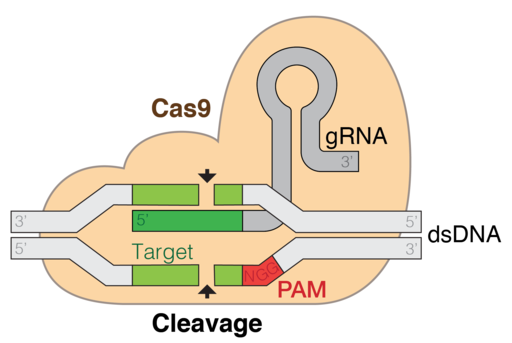 For the first time, genome-edited food is being sold on the open market. A recent article published on December 14th, 2021 outlines how CRISPR-Cas9 technology has been used to create genome-edited food. Consumers in Japan have been able to purchase genetically edited Sicilian Rouge tomatoes through the Tokyo-based company, Sanatech Seed. These genetically edited tomatoes have been altered to have high amounts of y-aminobutyric, aka GABA.
For the first time, genome-edited food is being sold on the open market. A recent article published on December 14th, 2021 outlines how CRISPR-Cas9 technology has been used to create genome-edited food. Consumers in Japan have been able to purchase genetically edited Sicilian Rouge tomatoes through the Tokyo-based company, Sanatech Seed. These genetically edited tomatoes have been altered to have high amounts of y-aminobutyric, aka GABA.
In Japan, consuming GABA is very popular. It is supposed to lower blood pressure and promote relaxation. It does so through reducing the excitement of neurons in the nervous system. GABA is an inhibition neurotransmitter in the nervous system.
To test its audience, in May 2021 Sanatech first sent seedlings for genome-edited tomatoes to 4,200 home gardeners in Japan. Because of the positive feedback and high demand, Sanatech started selling tomatoes to the general public.
The tomatoes are altered through CRISPR-Cas9 genome editing. CRISPR has successfully been used to alter foods, such as making mushrooms that don’t brown, or soybeans that are tolerant to drought. Although many foods have been regulated, these tomatoes by Sanatech are the first to be commercialized.
 CRISPR is a technology that can be used to edit the genes of prokaryotic organisms like archea and bacteria. CRISPR is a way of finding a specific sequence of DNA in a cell, and then altering that DNA. CRISPR-Cas9 (pictured to the right) is the enzyme which finds and binds with specific DNA strands complementary to the CRISPR sequence.
CRISPR is a technology that can be used to edit the genes of prokaryotic organisms like archea and bacteria. CRISPR is a way of finding a specific sequence of DNA in a cell, and then altering that DNA. CRISPR-Cas9 (pictured to the right) is the enzyme which finds and binds with specific DNA strands complementary to the CRISPR sequence.
 DNA is a polymer which carries the genetic instructions for an organism. It is made up of two strands of bases (two polynucleotide chains) which compliment each other. Each base in a strand of bases can be one of four nucleotides, adenine, thymine, guanine, and cytosine. One nucleotide, or base, on one side of the DNA double helix matches with the corresponding base on the other side of the DNA to form a base pair. Adenine nucleotides must match with thymine, and guanine must match with cytosine.
DNA is a polymer which carries the genetic instructions for an organism. It is made up of two strands of bases (two polynucleotide chains) which compliment each other. Each base in a strand of bases can be one of four nucleotides, adenine, thymine, guanine, and cytosine. One nucleotide, or base, on one side of the DNA double helix matches with the corresponding base on the other side of the DNA to form a base pair. Adenine nucleotides must match with thymine, and guanine must match with cytosine.
 Sanatech increased GABA in the tomatoes by altering GABA’s metabolic pathway, aka the GABA shunt. They first inserted a strand of guide RNA along with the enzyme CRISPR-Cas9. This guide RNA is a strand that compliments the part of the DNA strand Sanatech wishes to disable: the gene that encodes CaMBD (calmodulin binding dominant). The RNA strand attaches, and the enzyme CRISPR-Cas9 cuts the DNA sequence Sanatech wishes to remove out. Disabling the gene that encodes CaMBD increases the enzyme glutamic acid decarboxylase’s activity. This enzyme catalyzes the decarboxylation of glutamate to GABA, raising GABA levels.
Sanatech increased GABA in the tomatoes by altering GABA’s metabolic pathway, aka the GABA shunt. They first inserted a strand of guide RNA along with the enzyme CRISPR-Cas9. This guide RNA is a strand that compliments the part of the DNA strand Sanatech wishes to disable: the gene that encodes CaMBD (calmodulin binding dominant). The RNA strand attaches, and the enzyme CRISPR-Cas9 cuts the DNA sequence Sanatech wishes to remove out. Disabling the gene that encodes CaMBD increases the enzyme glutamic acid decarboxylase’s activity. This enzyme catalyzes the decarboxylation of glutamate to GABA, raising GABA levels.
Increasing GABA levels is said to be a healthy way to decrease stress and lower blood pressure, and people around the world love being able to do so through eating everyday foods, such as tomatoes. People are also more accepting of these genome altered tomatoes because they have been edited specifically by CRISPR, which is a pretty trusted and well known form of gene editing technology. CRISPR technology has, and will, change the world by giving humans the power to alter and change DNA.


Leave a Reply